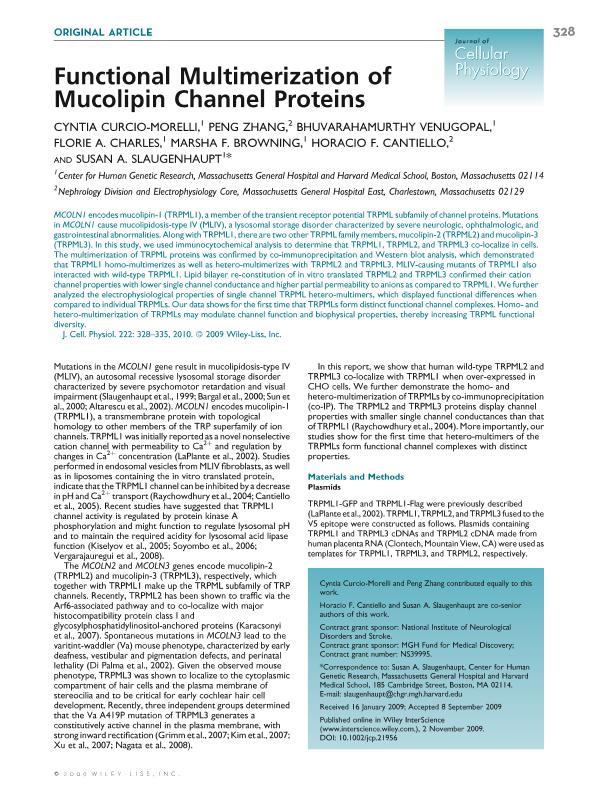Artículo
Functional multimerization of mucolipin channel proteins
Curcio Morelli, Cyntia; Zhang, Peng; Venugopal, Bhuvarahamurthy; Charles, Florie A.; Browning, Marsha F.; Cantiello, Horacio Fabio ; Slaugenhaupt, Susan A.
; Slaugenhaupt, Susan A.
 ; Slaugenhaupt, Susan A.
; Slaugenhaupt, Susan A.
Fecha de publicación:
02/2010
Editorial:
Wiley
Revista:
Journal of Cellular Physiology
ISSN:
0021-9541
e-ISSN:
1097-4652
Idioma:
Inglés
Tipo de recurso:
Artículo publicado
Clasificación temática:
Resumen
MCOLN1 encodes mucolipin-1 (TRPML1), a member of the transient receptor potential TRPML subfamily of channel proteins. Mutations in MCOLN1 cause mucolipidosis-type IV (MLIV), a lysosomal storage disorder characterized by severe neurologic, ophthalmologic, and gastrointestinal abnormalities. Along with TRPML1, there are two other TRPML family members, mucolipin-2 (TRPML2) and mucolipin-3 (TRPML3). In this study, we used immunocytochemical analysis to determine that TRPML1, TRPML2, and TRPML3 co-localize in cells. The multimerization of TRPML proteins was confirmed by co-immunoprecipitation and Western blot analysis, which demonstrated that TRPML1 homo-multimerizes as well as hetero-multimerizes with TRPML2 and TRPML3. MLIV-causing mutants of TRPML1 also interacted with wild-type TRPML1. Lipid bilayer re-constitution of in vitro translated TRPML2 and TRPML3 confirmed their cation channel properties with lower single channel conductance and higher partial permeability to anions as compared to TRPML1. We further analyzed the electrophysiological properties of single channel TRPML hetero-multimers, which displayed functional differences when compared to individual TRPMLs. Our data shows for the first time that TRPMLs form distinct functional channel complexes. Homo- and hetero-multimerization of TRPMLs may modulate channel function and biophysical properties, thereby increasing TRPML functional diversity.
Palabras clave:
Ml1
,
Multimerization
Archivos asociados
Licencia
Identificadores
Colecciones
Articulos(OCA HOUSSAY)
Articulos de OFICINA DE COORDINACION ADMINISTRATIVA HOUSSAY
Articulos de OFICINA DE COORDINACION ADMINISTRATIVA HOUSSAY
Citación
Curcio Morelli, Cyntia; Zhang, Peng; Venugopal, Bhuvarahamurthy; Charles, Florie A.; Browning, Marsha F.; et al.; Functional multimerization of mucolipin channel proteins; Wiley; Journal of Cellular Physiology; 222; 2; 2-2010; 328-335
Compartir
Altmétricas



